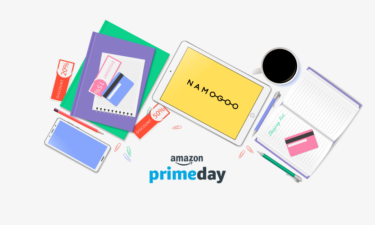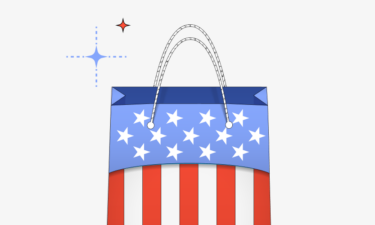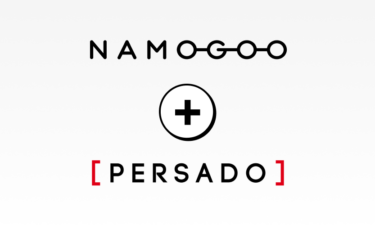What Is Discount Pricing?
Discount pricing is a pricing strategy wherein products are offered at a reduced price to consumers.
Some of the common reasons for this price adaptation strategy include:
- Customer Acquisition. Research shows that discounts increase shoppers’ oxytocin levels by up to 38%[*]. Oxytocin is considered the happy hormone, and it encourages engagement with your brand.
- Increased Conversions. Price discounts can help to improve sales volume by increasing conversions. Between 28% and 30% of consumers surveyed cited that they are more likely to convert when offered discount pricing[*].
- Customer Retention. Repeat customers account for more than half of the annual revenues of businesses[*]. With your eCommerce store’s profitability in mind, you can retain more customers to drive customer lifetime value by offering discount pricing for loyal customers. This is exactly what a subscribe and save discount can do.
- Clear Excess Inventory. There are times when you need to clear excess inventory to make room for a new product line or reduce loss. Discount pricing can help to move this stock.
One crucial step to building a successful eCommerce conversion funnel is determining your pricing strategy. There are many pricing strategies, but today we will focus on discount pricing.
Discount pricing is often confused with promotional pricing, however, they’re not the same. Promotional pricing entails a temporary pricing decrease surrounding a specific campaign or sales promotion, whereas discount pricing strategies aren’t always tied to marketing activity.
Next, we’ll go over the benefits of discount pricing, as well as the pitfalls so you can determine whether this pricing strategy has a place in your eCommerce business.
5 Benefits of Establishing a Discount Pricing Strategy
Whether you hate them or love them, discounts are prevalent in eCommerce. Between promotional campaigns, volume pricing, and discount pricing, most eCommerce brands expect to provide some level of discount to shoppers.
But discounting is a fine line to balance.
Discounted prices, when used effectively, can drive revenue, but if done incorrectly, they can devalue your brand. Here are a few benefits of discount pricing, and then we’ll review the drawbacks.
#1. Drive Conversions and Reduce Time to Purchase
92% of shoppers used discount codes in 2019[*].
And according to Shopify, merchants with an active discount code are 8x times more likely to make a sale[*]. Across the eCommerce platform, 17% of total eCommerce conversions were transacted using a discount coupon within 365 days.
This suggests that discounts drive conversions and help to reduce the time to purchase, and it is one of the most important reasons why most eCommerce brands use discount pricing.
#2. Improve Customer Loyalty & Retention
Offering discount pricing to existing customers for repeat purchases, either through a loyalty program or as a regular part of a customer retention strategy is an effective tactic.
Statistics show that 20% of your existing customers will make up 80% of your company’s revenue[*], and a 5% increase in customer retention can increase your profits by up to 95%[*].
Incentivizing existing customers to repurchase or try your other products via discount pricing can make them feel valued and reduce their likelihood of moving on to a competitor.
#3. Enhanced Inventory Management
Old stock or excess inventory can be a significant expense for eCommerce brands. It slows revenue, raises carrying costs, and takes up valuable warehouse space, which in turn affects profitability.
Establishing a discount pricing strategy for excess, expiring, or last-season inventory can be an effective method of inventory management.
Selling overstock or aged inventory with a discount pricing strategy can help your supply chain team to make shelf space for new skus, and reduce inventory waste.
#4. Establish a Steady Source of Monthly Recurring Revenue
Monthly recurring revenue (MRR) has traditionally been the domain of SaaS products in the B2B space.
But challenger consumer product brands like Dollar Shave Club have flipped the script by implementing subscription models for eCommerce.
eCommerce subscriptions empower brands to benefit from the holy grail of MRR by offering an auto-ship program at regular, set intervals. This takes the onus off of the customer to remember or find the time to re-order, while also establishing a steady stream of recurring revenue for the brand.
The cornerstone of any subscription program? Discount pricing. Offering a small discount (e.g. 10% off) on every shipment entices customers to join the program.
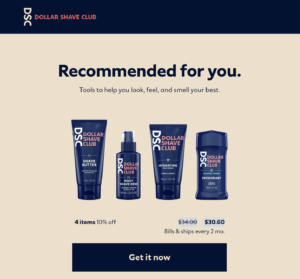
That’s why eCommerce teams often refer to their subscription programs as “subscribe and save”!
#5. Help Customers Choose Your Products Over Competitors
Studies show that offering a discount can deter customers from looking for the same product elsewhere[*]. This is because discounts generate a sense of urgency to buy, which diverts buyers’ attention from other options.
Discount pricing may also help to build your brand’s reputation by delivering good value.
For example, say you work with an eCommerce dinnerware brand. If your store develops a reputation as a great place to find good dinnerware at reasonable prices compared to your competitors, you’ve tapped into one of the most effective marketing strategies: word-of-mouth magic.
3 Pitfalls of Discount Pricing in eCommerce
Discounting has many advantages, but offering discounts too frequently can have some unintended consequences.
Here are some reasons why discount pricing can hurt your brand value:
#1. Decreased Willingness to Pay
Discounts can attract customers driven by the reduced price rather than appreciate how your product solves their problem.
When you give a discount, you’re usually diverting your customer’s focus from your product and placing it on price, and price becomes the primary feature that matters to them.
Their willingness to pay your full price (after discounts are removed) may decrease.
#2. Lowered Customer Perceived Value
If you offer frequent discounts, you subconsciously make price the primary factor to shop from your store. In the long run, your shoppers devalue your product and can’t see any benefit in what you’re offering at the price point.
The major retailer JCPenney learned this the hard way when they gave discounts to boost sales[*]. Sales increased as predicted, but the difficulty came when it sought to abandon its long-standing discount policy to improve margins and profitability.
Even when JC Penney decided to revert to its former strategy, sales began to decline, as customers’ perceptions of the brand had already been threatened.
Discount prices can make or breakyour brand equity. After all, offering discounts to your pricing too generously, too often, or too broadly, and you’re in danger of training customers to expect a discount, harming your customer perceived value.
#3. Risk Of Losing Your eCommerce Profitability
Discounts are a short-term strategy, and running excessive discounts can lead to unsustainable expectations from your customers.
If you offer extreme discounts for an extended period without considering your margins, you’ll reduce your profitability and stunt your growth, as you won’t have as much profit to reinvest into growth channels.
In reality, most customers attracted to a business through discounting never return. So, discounting can be dangerous as most eCommerce brands get trapped in thinking that it is a profitable strategy.
While there is a range of discount pricing tactics available, some are better suited to specific types of businesses than others.
This brings us to our next question: what are the different types of discount pricing strategies?
9 Discount Pricing Strategies That Work For eCommerce Brands
The price of a product or service is a significant factor in your potential customer’s buying decision. Discount prices can be a deal-maker in the competitive world of eCommerce, where shoppers have more options than ever before.
To help you figure out how to offer a discount, we’ve compiled a list of the most effective discount pricing strategies.
#1. Discount Pricing Based on Customer Intent
Discounts are a short-term strategy, and running excessive discounts can lead to unsustainable expectations from your customers.
It goes without saying that humans are inclined towards rewards and incentives that motivate them. But what motivates one shopper to convert won’t necessarily motivate another.
Each visitor that lands on your eCommerce site comes with a different point of view, purchase intention, and set of motivations – a distinctive shopping “genetic code”.
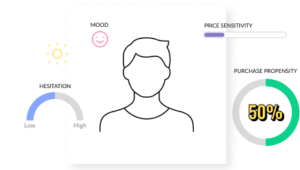
The drawbacks of discount pricing that we reviewed earlier will be felt mostly by the online retailers that fail to deliver personalized experiences based on this unique buyer DNA.
And while there are certainly downsides to discount pricing, discounting can provide incredible opportunities for growth when built into your pricing strategy strategically. You just need to know when to provide a discount – and to whom.
Instead of indiscriminately offering the same discount pricing to everyone, consider offering individualized incentives that are most likely to motivate each shopper, whether that be a discount, free shipping, or no incentive at all.
You’re already using customer intent to bring in traffic. Start leveraging customer intent for those pivotal moments of conversion that are happening on your site.
Namogoo’s AI-based Intent-Based Promotions calculates each shopper’s motivations by identifying their intent signals and calculating their purchase propensity. This service delivers the minimum incentive needed to convert them at the right point in their customer journey.
Brands that have used Intent-Based Promotions report a:
- 15% increase in conversions and revenue
- 45% less time to purchase
- 25% cut in discounting rate and promotional costs
- 15% reduction in cart abandonment rate.
All without having to take on the downfalls of a discount pricing strategy. Magic? Not quite, but it sure feels like it!
#2. Seasonal Discount Pricing
Seasonal discounting can be an effective method of attracting shoppers with limited-time discounts and these promotions are known to drive surges in traffic to eCommerce sites.
Such discounts are usually applied to products that are becoming seasonally redundant, allowing the brand to make room for incoming inventory and the consumer to score a deal for next year. Check out how the clothing brand The Gap does this with spring sales:

Seasonal discounting is also common around holidays.
According to Adobe Analytics, holiday season online sales have set a new record in 2021[*]. In November and December, online buyers in the United States spent $204.5 billion, up 8.6% year over year.
American consumers are under societal pressure to buy during the holiday season due to cultural norms of gift giving. So, offering a seasonal discount will help you emotionally connect with your shoppers, while helping you to offload excess inventory.
#3. Volume Discount Pricing
Also known as quantity discount pricing, this type of pricing strategy is implemented wherein a price reduction is offered to buyers for bulk orders.
There are two types of volume discounts:
- Non-Cumulative Quantity Discount: This type of discount is offered only on one order, encouraging buyers to place high-volume orders.
- Cumulative Quantity Discount: This type of discount is offered on all orders over a specified period, and it encourages buyers for repeated purchases.
Volume discount strategy usually works for B2B eCommerce channels. Check out how The Home Depot does this by offering a discount on bulk orders:
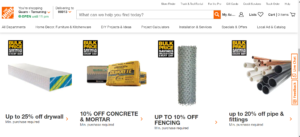
Volume discount pricing can also be effective for consumer goods eCommerce brands where the products offered are consumable.
#4. Bundle Discount Pricing
This is a strategy where two or more products/services are clubbed together and sold at a price that is either lower than the accumulative prices of individual components or the same price when two or more products are added.
See how Doe Lashes bundles their false silk lashes:
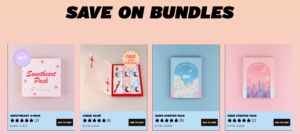
The brand increased its average order value by 86% after introducing bundles[*].
Bundling products can help you to offload slow-moving and excess inventory stocks. But along with bundles, you should also offer the flexibility to buy individual products.
For example, a hair care brand may create a bundle that includes a shampoo, a conditioner, and a hair serum. If a customer doesn’t need or want hair serum, they may not buy the bundle. In that case, you should ensure customers have the freedom to purchase individual products.
Bundle pricing is beneficial for both customers and retailers. It will allow your buyers to save time when shopping and help you to increase revenue and conversions.
#5. Subscription Discount Pricing
As we reviewed earlier, one use case for discount pricing is to motivate customers to sign up for your subscribe and save program.
Product subscriptions are the gold standard for customer lifetime value because they encourage repeat purchases by taking the initiative to re-order off of the customer through automation.
All customers have to do is sign up for the program, and they will be auto-shipped their products of choice on a schedule they choose, earning the brand monthly recurring revenue. See this example from the health and beauty brand, Blume, below:
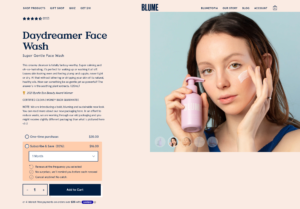
Most brands incentivize their customers to sign up for the subscribe and save program through discount pricing, offering a 10-20% discount on every shipment.
#6. Repeat Customer Discount Pricing
Customers love being rewarded, and if they are repeat customers, their expectation of getting a reward increases. So why not leverage the psychology of discounts to make more money from existing customers?
For example, H&M awards loyalty points to their customers for shopping with them.

While this isn’t a direct discount, this falls into the category of discount pricing because points are used toward purchases.
#7. New Customer Discount Pricing
eCommerce brands provide discounts to first-time buyers to build sustainable relationships with them. Such deals encourage shoppers to make a first-time purchase with a brand that is new to them.
Check out how Namogoo customer Son de Flor provides a 10% off the first purchase:

A 2012 survey found that a discount attracts close to 80% of new customers[*]. In another survey two-thirds of consumers purchased just because they found a discount[*].
In the absence of such deals, many customers would otherwise abandon their carts.
#8. Referral Discounts
Customers receive these discounts when referring a new customer to your brand.
This referral code is a two-way discount, with the new client receiving a discount on their first purchase and the referrer receiving discounts based on the number of new customers they bring in.
See how Bonobos does this by offering 25% off to both parties:

This discount approach can increase organic traffic and generate awareness of your brand.
Some stats say that customers referred to your brand are 5X more likely to use your referral program than those who weren’t[*], helping your referral program become a self-fulfilling prophecy.
#9. Email Subscription Discounts
Email marketing is the soul of eCommerce. Offering a customer a discounted product or service to sign up for promotional newsletters attracts customers to your business, and helps you to nurture the customer lifecycle, priming the pump for customer lifetime value.
Check out how Saks Fifth Avenue does this by offering 10% off in exchange for visitor’s email addresses:
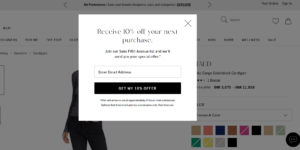
A study revealed that customers rated email discounts as the most influential factor in their purchasing decisions (at 4.15 on a scale of 1 to 7)[*]. But that isn’t all they desire.
Emails with product content received a score of 4.1 on the scale. This demonstrates that customers want more content from your emails, such as product information, which impacts their purchasing decision.
Take a Thoughtful Approach to Discount Pricing
Discount pricing is an effective strategy for increasing sales and moving inventory, but it isn’t for every company.
Every brand should take a thoughtful approach to discount pricing strategies because there’s no universal answer for when, where, or how to apply them.
To ensure you’re making a smart decision about your pricing strategy, review what you’re trying to achieve as well as your brand values and what type of brand your company is aiming to be.
And remember: you don’t have to decide on discount pricing as your pricing strategy to reap the benefits of it.
Tailoring your incentives to each individual customer based on their intent through Intent-Based Promotions can provide all of the upsides with none of the downsides.





